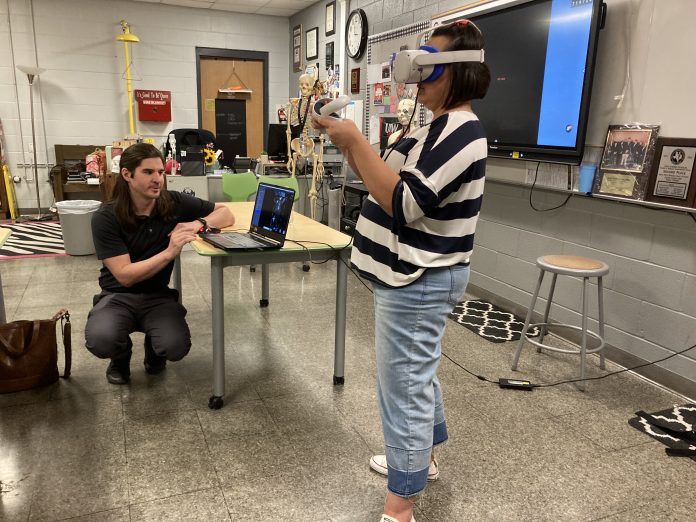It wasn’t your ordinary professional development.
Michael Morehead, CEO of syGlass, a virtual reality software firm, offered George H.W. Bush New Tech Odessa teachers a chance to enter parts of human and animal bodies through VR goggles.
On May 26, it eight career and technical education teachers looked at human hearts, brains and knees, a baby chameleon and a zebra fish, to name a few.
A second group of 16 to 18 teachers from all subjects at NTO participated May 27.
The object was to show how cutting-edge technology can be used to engage students and introduce them to careers they never thought about before.
“We have teachers here today that are learning how to embed this into learning about cells; learning about the brain. So now they can … use this technology tool to integrate that into their classroom,” Chief Innovation Officer Jason Osborne said. “At the same time, students have real data that they’re looking at.”
“This is a personal learning opportunity for health science instructors. They’ll learn how to use the VR and also learn how to manipulate the data to get prepared for the fall,” Osborne added. “This is an exciting expansion of virtual reality in the district. We feel Ector County ISD is ahead of the curve when it comes to embedding sophisticated technology advances in virtual reality.”
Osborne found searched for about a year and a half before finding Morehead and syGlass.
“What I wanted is an opportunity for kids to manipulate scientific data in a more realistic fashion and also in a technology that they want to be in,” Osborne said.
He didn’t find what he was looking for until around 2018.
“I was presenting at UT Austin at a neuroscience conference. I was at that conference because we were starting to talk about starting a neuroscience course at Ector County ISD and lo and behold he (Morehead) gave a talk about this virtual reality tool they developed …,” Osborne said.
Osborne approached the company and asked if it would be willing to partner with ECISD, teachers and students to pilot the software that is designed for science and develop it into an educational tool.
The company agreed and now ECISD has districts around the country that want to replicate what’s being done here.
Teachers can now talk to experts in a variety of scientific and medical fields, for example, and they get job embedded professional learning.
Teachers from any content area can use VR in their classes and show students that it can be applied in the real world. Professionals and professors who are experts in their field can also record videos students can watch.
Osborne added that teachers can expand on that.
“I think it’s going to be exciting for teachers because they don’t have to be the content expert. They can facilitate the information and they can learn along with the students,” he said.
With some of the really complex anatomy and science they will now have support.
“They have an extension of their classroom through these professionals in the field. It also bridges the gap between k-12 education and postsecondary,” Osborne said.
He added that it creates more natural pathways through partnerships, so students may be more willing to move on to postsecondary education.
“Just like any one of us, we don’t know what we don’t know until we are exposed to something. The fact that we are exposing students to a whole new world of possibilities, now they can create many pathways in their professional career because now they see there’s so much more out there. Through virtual reality, it just gives us that extra edge to give them access to something they didn’t even know existed,” Osborne said.
Christina Portillo, who teaches phlebotomy and medical systems, said she thought Morehead’s presentation was pretty cool.
“I think it actually gives the kids a chance to … explore the organs of the body. It’s different when it’s on the model. When they can manipulate it and turn it upside down, I think it would be great for them to learn it that way,” Portillo said.
“They’re more hands-on, this generation … They have to touch it; feel it. This would be great for them to pull it apart and manipulate it, or to spread the organs out and say, okay, now put it back. Where does it go? It would be a fun thing to use in the classroom,” she added.
Morehead said this was the first time had had conducted professional development sessions for teachers.
For the past seven years, the software has been used by neuroscientists and structural biologists in basic science research, he said.
“Our customer base is not really the teacher. It’s really only Odessa. Jason saw the potential, brought it here and this pilot has proven it in the educational realm and now the company’s thinking about where we should go and what we should do is completely changed after this pilot,” Osborne said.
He said the technology has existed for a couple of years.
“We’ve added some things that are more useful in scientific communication, but it only has utility if people can deploy it on the ground. By coming here and showing the teachers what’s possible, this is the first step to getting it actively used in the classroom,” Morehead said.
Neuroscience is one of the fastest growing science fields.
“… There’s always a demand for cutting-edge research. But syGlass is really more than just a tool for neuroscientists. Since we can show gross anatomy; we can show comparative anatomy with animal scans; we can show cell biology. We even have some plans to teach different concepts in mathematics inside of virtual reality. So it’s not just about neuroscience at all, although it is a great tool for showcasing neuroscience datasets,” Morehead said.




